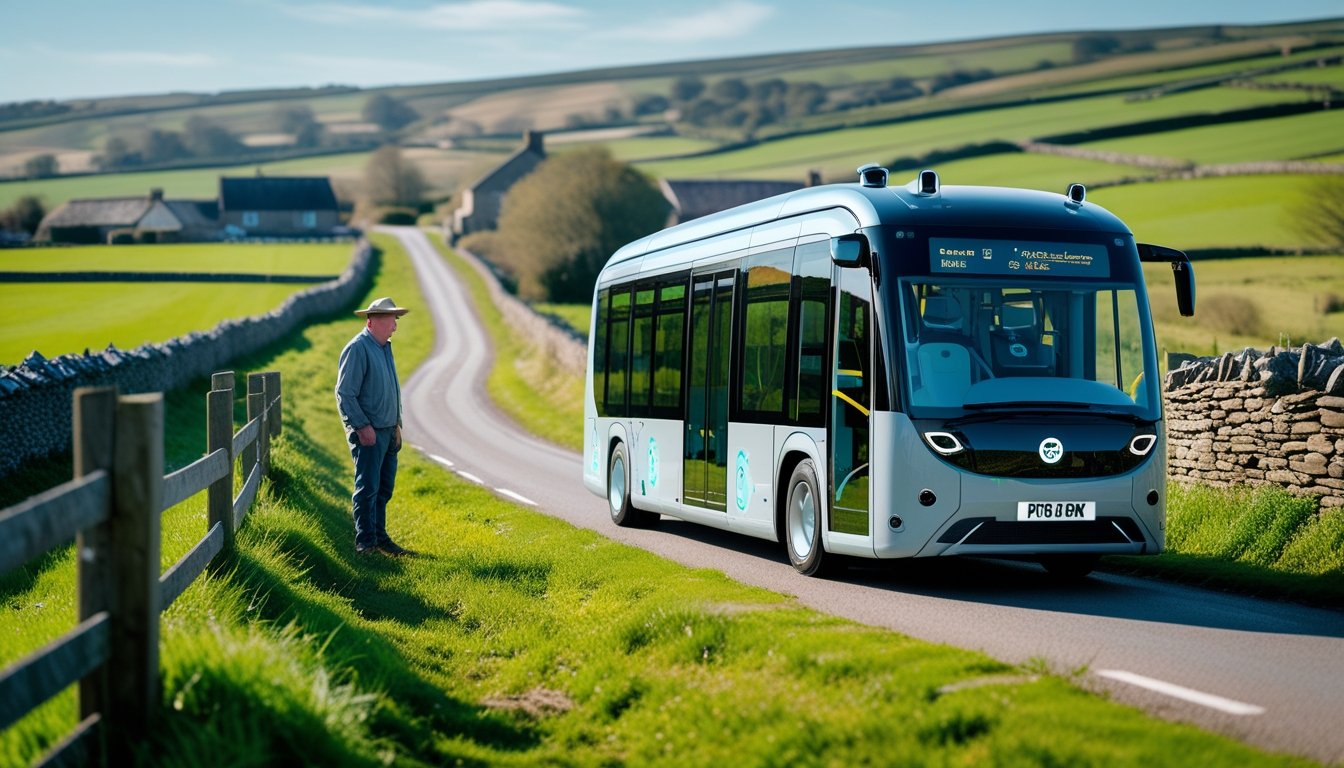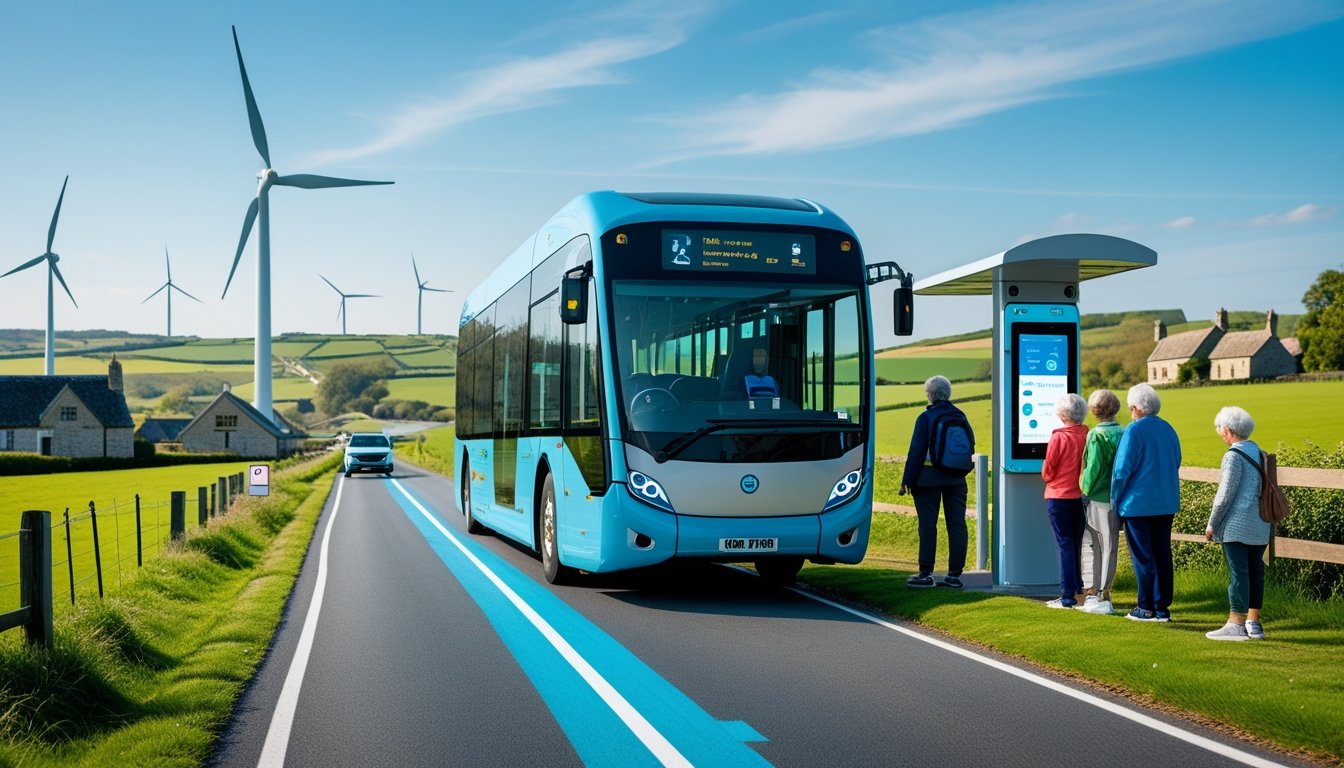Late updated: 26 Oct 2025 08:10
Written by: Oliver Bennett
AI Disruptions In UK Rural Transportation: Impacts and Innovations
Artificial intelligence is reshaping how we navigate rural transportation in the UK. We are seeing significant enhancements in efficiency and sustainability, two critical factors in the success of rural transport systems. AI-driven systems analyse data to streamline operations, enabling rural networks to optimise routes and schedules, thereby improving reliability and reducing waiting times. With these advancements, our rural communities can benefit from more predictable travel experiences, making transport systems more inclusive and accessible.

Another area where AI is making a substantial impact is in the logistics sector. Innovations such as delivery robots are not only transforming urban landscapes but are also finding their place in rural settings. Automated systems, equipped with predictive maintenance capabilities, can significantly reduce operational costs and minimise disruptions. These technologies ensure smoother, more efficient services, ultimately benefiting both service providers and passengers.
As we embrace these changes, it's imperative to consider the balance between innovation and responsible implementation. The UK's Transport Artificial Intelligence Action Plan highlights our commitment to harnessing AI's power while carefully managing potential risks. Our collective focus remains on ensuring safety, reducing carbon emissions, and boosting the skill set of our workforce.
Key Takeaways
- AI optimises rural transport efficiency and reliability.
- Automated logistics innovations enhance rural services.
- Responsible AI implementation is key for safety and sustainability.
AI Disruptions in UK Rural Transportation
In recent years, artificial intelligence has been reshaping rural transportation across the UK. This transformation includes key applications such as route optimisation, the involvement of local authorities in implementing AI strategies, and the challenges faced during AI implementation in rural areas.
Key AI Applications in Rural Transport
AI technologies are revolutionising rural transport systems through several applications. Route optimisation is paramount, as AI analyses travel patterns and real-time traffic conditions to determine efficient routes. This shortens journey times and maximises vehicle utilisation.
AI also enhances vehicle automation, such as autonomous delivery vehicles. These solutions improve delivery efficiency in less accessible areas. Furthermore, AI-powered traffic management systems provide dynamic adjustments to traffic flow, which is valuable in accommodating unexpected changes and enhancing overall safety.
Role of Local Authorities in AI-Led Transformation
Local authorities have a pivotal role in driving AI transformations in rural transportation. They are responsible for creating conducive environments for AI deployment. This involves promoting infrastructure development and ensuring connectivity, which is foundational for implementing smart technologies.
Authorities also provide support through funding initiatives and partnership opportunities. This collaborative approach enables private sector innovations to integrate with public transportation systems. Moreover, local organisations engage with community stakeholders to understand their needs, ensuring that AI solutions are tailored to the specific challenges faced by rural residents.
Barriers to AI Implementation in Rural Areas
Several challenges hinder AI adoption in rural transportation. Connectivity issues are significant, as inconsistent internet and mobile network coverage can disrupt AI systems. This affects data transmission and real-time decision-making capabilities.
Financial constraints also play a considerable role. Implementing cutting-edge AI technologies requires substantial investment, often beyond the reach of smaller rural communities. An additional barrier is the lack of technical expertise. Rural areas may face difficulties in finding and retaining skilled personnel necessary for AI system maintenance and development.
Despite these barriers, ongoing efforts to bridge these gaps promise significant advancements in the future.
Impact and Considerations of AI in Rural Transport

AI is reshaping rural transport by enhancing environmental outcomes, boosting security and resilience, and posing new skill requirements in the workforce. The potential for transformation is significant, yet specific challenges must be addressed to harness these benefits effectively.
Environmental Implications and Decarbonisation
AI holds the potential to significantly reduce environmental impact in rural transport. Through optimised routing and predictive maintenance, AI can minimise fuel consumption and emissions. For instance, intelligent systems can forecast the best routes that avoid congestion, thus cutting down unnecessary idling.
Another promising aspect is the integration of AI in electric vehicle management. By balancing load demands and predicting energy usage, AI can foster a seamless transition to electric transport networks. This enhances the decarbonisation goals of rural areas, where traditional transport contributes substantially to emissions.
Environmental sustainability is an urgent need, and AI innovations can be instrumental in achieving these objectives. As we embed AI into transport systems, we must consider ways to maximise these environmental benefits while addressing any potential barriers to implementation.
Improving Security and System Resilience
AI adds a critical layer of security and resilience to rural transport systems. Predictive analytics powered by AI can anticipate or detect issues before they lead to system failures, thus making our transport networks more robust.
It allows for real-time monitoring and rapid response to emergencies. With enhanced data analysis, AI tools can quickly identify patterns or anomalies, allowing swift action to mitigate risks.
The resilience AI offers is crucial in rural areas, where resources for maintenance and emergency response are often limited. The ability to proactively manage and maintain infrastructure not only protects assets but also ensures the continuity of reliable transport services.
Workforce Skills and Adoption Challenges
The adoption of AI in rural transport introduces new workforce challenges. There is a clear demand for upskilling current workers to handle AI technologies effectively. Training programmes that focus on AI literacy are vital.
Our workforce must embrace a shift in skills, from traditional operational tasks to roles centred around AI management and maintenance. Resistance to change and limited access to training resources in rural areas can pose challenges.
Facilitating this transition requires strategic investments in education and training, ensuring that workers are equipped to thrive in an AI-enhanced environment while considering the unique constraints faced by rural areas.
Frequently Asked Questions

AI is reshaping rural UK transportation by enhancing efficiency, boosting sustainability, improving safety, and having implications on employment. Changes necessitate adaptation by local communities.
How is artificial intelligence improving efficiency in the logistics and transport sectors in rural UK?
AI analyses travel patterns and real-time traffic conditions to identify efficient routes. This optimises vehicle usage, reduces waiting times, and enhances reliability. Such advancements streamline logistics and transport operations.
What challenges are faced by rural UK transport systems in the integration of AI technologies?
The integration of AI in rural transport faces technical and non-technical barriers. These include limited digital infrastructure, cost of technology implementation, and resistance to change among stakeholders, which can slow down adoption.
In what ways can AI contribute to sustainable rural transportation in the United Kingdom?
AI supports sustainability by enabling smarter route planning, which minimises fuel consumption and emissions. By optimising traffic flow and implementing predictive maintenance, AI helps reduce the environmental impact of transportation.
How is AI being utilised to enhance the safety of rural transportation networks in the UK?
AI enhances safety through advanced sensor networks and predictive maintenance that identify potential issues before they cause accidents. These technologies improve the management of transport networks, thereby increasing safety for passengers and operators.
What impact does AI have on employment within the rural transportation industry in Britain?
AI changes the employment landscape by potentially reducing demand for traditional roles but increasing opportunities in tech-oriented positions. Training and upskilling become essential as roles evolve with technological integration within the industry.
How are local communities in the UK's countryside adapting to changes brought by AI in transportation?
Rural communities are gradually adapting by embracing technology-driven conveniences, albeit with a degree of scepticism. As they experience improved connectivity and more efficient transport services, local acceptance and adaptation continue to grow.
